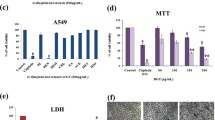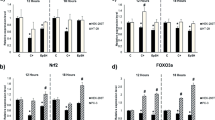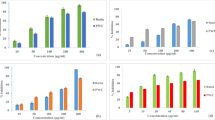Abstract
In our previous studies, a novel antimutagenic compound, 2-ethoxy-3-(3,7,11,15-tetramethylhexadec-2-ethyl) naphthaquinone-1,4-dione (ethoxy-substituted phylloquinone; ESP) from spinach was characterized and mechanism contributing to its antimutagenicity was deduced. In the current study, anti-proliferative activity of ESP was assessed in lung cancer (A549) cells using MTT [3-(4,5-dimethylthiazole-2yl)-2,5-diphenyl tetrazolium bromide], clonogenic assays and cell cycle analysis. ESP treatment showed selective cytotoxicity against lung cancer cells and no cytotoxicity in normal lung (WI38) cells. Cell cycle analysis revealed that ESP treatment arrests A549 cell population in G2-M phase. In-silico analysis indicated positive drug-likeness features of ESP. Molecular docking showed H-bonding and hydrophobic interactions between ESP and B-DNA dodecamer residues at minor groove. SWATH-MS (Sequential Window Acquisition of All Theoretical Mass Spectra) based proteomic analysis indicated down-regulation of proteins involved in EGFR signaling, NEDDylation and other metabolic pathways and up-regulation of tumor suppressor (STAT1 and NDRG1) proteins. Treatment of spinach powder with gamma radiation (5–20 kGy) from cobalt (Co-60) enhanced the extractability of ESP up to 4.4-fold at the highest dose of 20 kGy. Scanning electron microscopy of spinach powder displayed decrease in smoothness and compactness with increase in radiation dose attributing to its enhanced extractability. Increase in the extractability of ESP with increasing radiation doses as measured by fluorescence intensity and dry weight basis was strongly correlated. Nonetheless, radiation treatment did not affect the functionality of ESP in terms of anti-proliferative and antimutagenic activities. Current findings thus highlight broad spectrum bioactivity of ESP from spinach, its underlying mechanism and applicability of radiation technology in enhancing extractability.








Similar content being viewed by others
References
Bao P, Yokobori T, Altan B, Iijima M, Azuma Y, Onozato R et al (2017) High STMN1 expression is associated with cancer progression and chemo-resistance in lung squamous cell carcinoma. Ann Surg Oncol 24:4017–4024
Cheimonidi C, Samara P, Polychronopoulos P, Tsakiri EN, Nikou T, Myrianthopoulos V et al (2018) Selective cytotoxicity of the herbal substance acteoside against tumor cells and its mechanistic insights. Redox Biol 16:169–178
Chemat F, Rombaut N, Sicaire AG, Meullemiestre A, Fabiano-Tixier AS, Abert-Vian M (2017) Ultrasound assisted extraction of food and natural products. mechanisms, techniques, combinations, protocols and applications. A Review Ultrason Sonochem 34:540–560
Chen AY, Yu C, Gatto B, Liu LF (1993) DNA minor groove-binding ligands: a different class of mammalian DNA topoisomerase I inhibitors. Proc Natl Acad Sci USA 90:8131–8135
Collins BC, Hunter CL, Liu Y, Schilling B, Rosenberger G, Bader SL et al (2017) Multi-laboratory assessment of reproducibility, qualitative and quantitative performance of SWATH-mass spectrometry. Nat Commun 8:1–12
Cong Y, Cui Y, Wang S, Jiang L, Cao J, Zhu S et al (2020) Calcium-binding protein S100P promotes tumor progression but enhances chemosensitivity in breast cancer. Front Oncol 10:1–12
Corazzari M, Gagliardi M, Fimia GM, Piacentini M (2017) Endoplasmic reticulum stress, unfolded protein response, and cancer cell fate. Front Oncol 7:1–11
El-Sayed SM (2020) Use of spinach powder as functional ingredient in the manufacture of UF-soft cheese. Heliyon 6:1–6
Food Safety and Standards Authority of India (FSSAI) (2016) Draft food safety and standards (packaging and labelling) & (food products standards and food additives) (Amendment) regulations, 2015 related to inclusion of new atomic energy (radiation processing of food and allied products), Rules, 2012.
Freitas PAV, González-Martínez C, Chiralt A (2020) Application of ultrasound pre-treatment for enhancing extraction of bioactive compounds from rice straw. Foods 9:1–15
Fucikova J, Becht E, Iribarren K, Goc J, Remark R, Damotte D et al (2016) Calreticulin expression in human non-small cell lung cancers correlates with increased accumulation of antitumor immune cells and favorable prognosis. Cancer Res 76:1746–1756
Ghose S, Varshney S, Adlakha K, Bhat A, Naushin S, Seth S et al (2019) Quantitative proteomics study reveals differential proteomic signature in dilated, restrictive, and hypertrophic cardiomyopathies. J Proteins Proteomics 100:33–44
Golob-Schwarzl N, Schweiger C, Koller C, Krassnig S, Gogg-Kamerer M, Gantenbein N et al (2017) Separation of low and high grade colon and rectum carcinoma by eukaryotic translation initiation factors 1, 5 and 6. Oncotarget 8:101224–101243
Guardavaccaro D, Pagano M (2004) Oncogenic aberrations of cullin-dependent ubiquitin ligases. Oncogene 23:2037–2049
Gupta RS, Singh D (2006) Amelioration of CCl4-induced hepatosuppression by Spinacia oleracea L. leaves in wistar albino rats. Pharmacologyonline 3:267–278
Joerger AC, Fersht AR (2016) The p53 pathway: origins, inactivation in cancer, and emerging therapeutic approaches. Annu Rev Biochem 85:375–404
Kageyama S, Hanada E, Ii H, Tomita K, Yoshiki T, Kawauchi A (2015) Gamma-glutamylcyclotransferase: a novel target molecule for cancer diagnosis and treatment. Biomed Res Int 2015:1–5
Khan MA, Mahesh C, Semwal AD, Sharma GK (2015) Effect of spinach powder on physico-chemical, rheological, nutritional and sensory characteristics of chapati premixes. J Food Sci Technol 52:2359–2365
Komatsu H, Kakehashi A, Nishiyama N, Izumi N, Mizuguchi S, Yamano S et al (2013) Complexin-2 (CPLX2) as a potential prognostic biomarker in human lung high grade neuroendocrine tumors. Cancer Biomark 13:171–180
Kumar S, Chatterjee S, Tripathi J, Gautam S (2016) Purification and characterization of the principal antimutagenic bioactive as ethoxy-substituted phylloquinone from spinach (Spinacea oleracea L.) based on evaluation in models including human lymphoblast TK+/− cells. J Agric Food Chem 64:8773–8782
Kumar S, Gautam S, Sharma A (2015) Hurdle technology including chlorination, blanching, packaging and irradiation to ensure safety and extend shelf life of shelled sweet corn kernels. J Food Process Preserv 39:2340–2347
Kumar S, Kunwar A, Gautam S, Sharma A (2012) Inactivation of A. ochraceus spores and detoxification of ochratoxin A in coffee beans by gamma irradiation. J Food Sci 77:44–51
Kumar S, Tripathi J, Srivastava AK, Gautam S (2020) Molecular mechanism of antimutagenicity by an ethoxy-substituted phylloquinone (vitamin K1 derivative) from spinach (Spinacea oleracea L.). Chem Biol Interact 330:1–12
Kwon MJ, Seo J, Kim YJ, Kwon MJ, Choi JY, Kim TE et al (2013) Prognostic significance of CD151 overexpression in non-small cell lung cancer. Lung Cancer 81:109–116
Laskowski RA, Swindells MB (2011) LigPlot+: multiple ligand-protein interaction diagrams for drug discovery. J Chem Inf Model 51:2778–2786
Lee MY, Kim HA, Kang MH (2017) Comparison of lymphocyte DNA damage levels and total antioxidant capacity in Korean and American diet. Nutr Res Pract 11:33–42
Lester GE, Makus DJ, Hodges DM, Jifon JL (2013) Summer (subarctic) versus winter (subtropic) production affects spinach (Spinacia oleracea L.) leaf bionutrients: vitamins (c, e, folate, k1, provitamin a), lutein, phenolics, and antioxidants. J Agric Food Chem 61:7019–7027
Lim KH, Baines AT, Fiordalisi JJ, Shipitsin M, Feig LA, Cox AD et al (2005) Activation of RalA is critical for Ras-induced tumorigenesis of human cells. Cancer Cell 7:533–545
Lim SM, Jeong Y, Lee S, Im H, Tae HS, Kim BG et al (2015) Identification of β-lapachone analogs as novel MALT1 inhibitors to treat an aggressive subtype of diffuse large B-cell lymphoma. J Med Chem 58:8491–8502
Longnecker MP, Newcomb PA, Mittendorf R, Greenberg R, Willet W (1997) Intake of carrots, spinach, and supplements containing vitamin A in relation to risk of breast cancer. Cancer Epidemiol Biomark Prev 6:887–892
Madureira J, Barros L, Verde SC, Margaça FMA, Santos-Buelga C, Ferreira ICFR (2020) Ionizing radiation technologies to increase the extraction of bioactive compounds from agro-industrial residues: a review. J Agric Food Chem 68:11054–11067
Maurya DK (2017) ColonyCountJ: A user-friendly Image J Add-on Program for quantification of different colony parameters in clonogenic assay. J Clin Toxicol 358:1–4
Metha D, Belemkar S (2014) Pharmacological activity of Spinacia oleracea Linn. Asian J Pharm Res Dev 2:83–93
Moghadam AR, Patrad E, Tafsiri E, Peng W, Fangman B, Pluard TJ et al (2017) Ral signaling pathway in health and cancer. Cancer Med 6:2998–3013
Murphy D, Parker J, Zhou M, Fadlelmola FM, Steidl C, Karsan A et al (2010) Constitutively overexpressed 21 kDa protein in Hodgkin lymphoma and aggressive non-Hodgkin lymphomas identified as cytochrome B5b (CYB5B). Mol Cancer 9:1–19
Pensa S, Regis G, Boselli D, Novelli F, Poli V. (2013) STAT1 and STAT3 in tumorigenesis: two sides of the same coin? In: Madame Curie bioscience database. Landes Biosci Austin (TX).
Pereyra CE, Dantas RF, Ferreira SB, Gomes LP, Silva-Jr FP (2019) The diverse mechanisms and anticancer potential of naphthoquinones. Cancer Cell Int 19:1–20
Rao S, Oyang L, Liang J, Yi P, Han Y, Luo X et al (2021) Biological function of HYOU1 in tumors and other diseases. OncoTargets Ther 14:1727–1735
Roy R, Rahman MS, Raynie DE (2020) Recent advances of greener pretreatment technologies of lignocelluloses. Curr Res Green Sustain Chem 3:1–17
Sango DM, Abela D, McElhatton A, Valdramidis VP (2014) Assisted ultrasound applications for the production of safe foods. J Appl Microbiol 116:1067–1083
Schoenfeld AR, Davidowitz EJ, Burk RD (2000) Elongin BC complex prevents degradation of von Hippel-Lindau tumor suppressor gene products. Proc Natl Acad Sci USA 97:8507–8512
Singh AN, Sharma N (2020) Quantitative SWATH-based proteomic profiling for identification of mechanism-driven diagnostic biomarkers conferring in the progression of metastatic prostate cancer. Front Oncol 10:1–12
Soderlind KJ, Gorodetsky B, Singh AK, Bachur NR, Miller GG, Lown JW (1999) Bis-benzimidazole anticancer agents: targeting human tumour helicases. Anticancer Drug Des 14:19–36
Sun J, Zhang D, Bae DH, Sahni S, Jansson P, Zheng Y et al (2013) Metastasis suppressor, NDRG1, mediates its activity through signaling pathways and molecular motors. Carcinogenesis 34:1943–1954
Sung H, Ferlay J, Siegel RL, Laversanne M, Soerjomataram I, Jemal A et al (2021) Global cancer statistics 2020 GLOBOCAN estimates of incidence and mortality worldwide for 36 cancers in 185 countries. CA Cancer J Clin 71:209–249
Taheri S, Abdullah TL, Karimi E, Oskoueian E, Ebrahimi M (2014) Antioxidant capacities and total phenolic contents enhancement with acute gamma irradiation in Curcuma alismatifolia (Zingiberaceae) leaves. Int J Mol Sci 15:13077–13090
Tanaka T, Nakatani T, Kamitani T (2012) Inhibition of NEDD8-conjugation pathway by novel molecules: potential approaches to anticancer therapy. Mol Oncol 6:267–275
Teerasripreecha D, Phuwapraisirisan P, Puthong S, Kimura K, Okuyama M, Mori H et al (2012) In vitro antiproliferative/cytotoxic activity on cancer cell lines of a cardanol and a cardol enriched from Thai Apis mellifera propolis. BMC Complement Altern Med 12:1–17
Voragen AGJ, Coenen GJ, Verhoef RP, Schols HA (2009) Pectin, a versatile polysaccharide present in plant cell walls. Struct Chem 20:263–275
Wang H, Luo YH, Shen GN, Piao XJ, Xu WT, Zhang Y et al (2019a) Two novel 1,4-naphthoquinone derivatives induce human gastric cancer cell apoptosis and cell cycle arrest by regulating reactive oxygen species-mediated MAPK/Akt/STAT3 signaling pathways. Mol Med Rep 20:2571–2582
Wang Q, Pan F, Li S, Huang R, Wang X, Wang S et al (2019b) The prognostic value of the proteasome activator subunit gene family in skin cutaneous melanoma. J Cancer 10:2205–2219
Wang X, Ning Z, Lv M, Sun C (2021) The investigation of ultrasonic energy attenuation in aqueous solutions. J Phys Soc Japan 90:1–7
White V, Ruparelia P (2020) Kumar & Clark’s clinical medicine, 10th edn. Elsevier, Amsterdam, p 975
Xie D, Wu X, Lan L, Shangguan F, Lin X, Chen F et al (2016) Downregulation of TFAM inhibits the tumorigenesis of non-small cell lung cancer by activating ROS-mediated JNK/p38MAPK signalling and reducing cellular bioenergetics. Oncotarget 7:11609–11624
Yang C, Liu X, Li C, Li S, Du W, Yang D (2018) Eukaryotic translation initiation factor 3 subunit G (EI F3G) resensitized HC T116/5-Fu to 5-fluorouracil (5-Fu) via inhibition of MRP and MDR1. Onco Targets Ther 11:5315–5324
Yang HC, Wu YH, Yen WC, Liu HY, Hwang TL, Stern A et al (2019) The redox role of G6PD in cell growth, cell death, and cancer. Cells 8:1–29
Zhang Y, Baysac KC, Yee LF, Saporita AJ, Weber JD (2014) Elevated DDX21 regulates c-Jun activity and rRNA processing in human breast cancers. Breast Cancer Res 16:1–18
Zhang X, Zhang SC, Sun D, Hu J, Wali A, Pass H et al (2011) New insight into the molecular mechanisms of the biological effects of DNA minor groove binders. PLoS ONE 6:1–12
Zhou Z, Gong Q, Lin Z, Wang Y, Li M, Wang L et al (2020) Emerging roles of SRSF3 as a therapeutic target for cancer. Front Oncol 10:1–17
Zhu H, Chen L, Zhou W, Huang Z, Hu J, Dai S et al (2013) Over-expression of the ATP5J gene correlates with cell migration and 5-fluorouracil sensitivity in colorectal cancer. PLoS ONE 8:1–11
Zihlif M, Catchpoole DR, Stewart BW, Wakelin LP (2010) Effects of DNA minor groove binding agents on global gene expression. Cancer Genomics Proteomics 7:323–330
Acknowledgements
Authors acknowledge Dr. Dheeraj Jain (Chemistry Division, BARC) and Smt. Reema Devi Singh, Nuclear Agricultural and Biotechnology Division, BARC for their technical assistance. BARC is a Government of India R&D institute and so funding information is not applicable.
Author information
Authors and Affiliations
Contributions
SK, SG and DKM: conceptualization, writing-original draft and editing; SK, JT, DKM and JN: investigation/analysis and validation; SK: data curation; SG: supervision.
Corresponding author
Ethics declarations
Conflict of interest
Authors declare no conflict of interest with respect to the study described in the manuscript.
Supplementary Information
Below is the link to the electronic supplementary material.
Rights and permissions
Springer Nature or its licensor holds exclusive rights to this article under a publishing agreement with the author(s) or other rightsholder(s); author self-archiving of the accepted manuscript version of this article is solely governed by the terms of such publishing agreement and applicable law.
About this article
Cite this article
Kumar, S., Tripathi, J., Maurya, D.K. et al. Anti-proliferative effect and underlying mechanism of ethoxy-substituted phylloquinone (vitamin K1 derivative) from Spinacia oleracea leaf and enhancement of its extractability using radiation technology. 3 Biotech 12, 265 (2022). https://doi.org/10.1007/s13205-022-03264-6
Received:
Accepted:
Published:
DOI: https://doi.org/10.1007/s13205-022-03264-6




